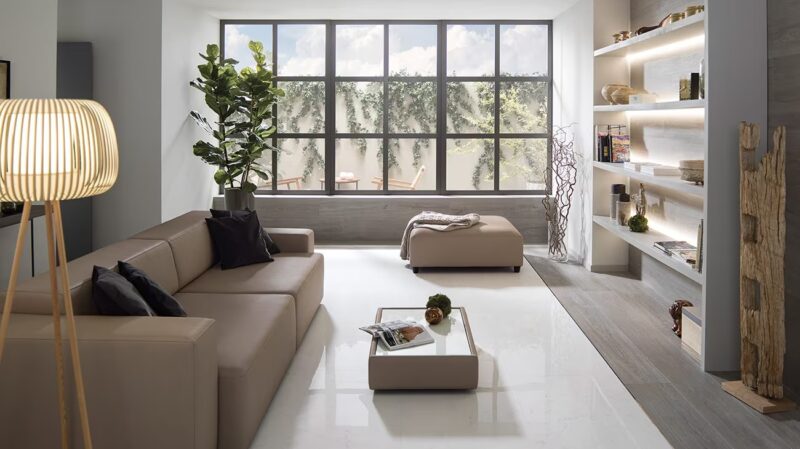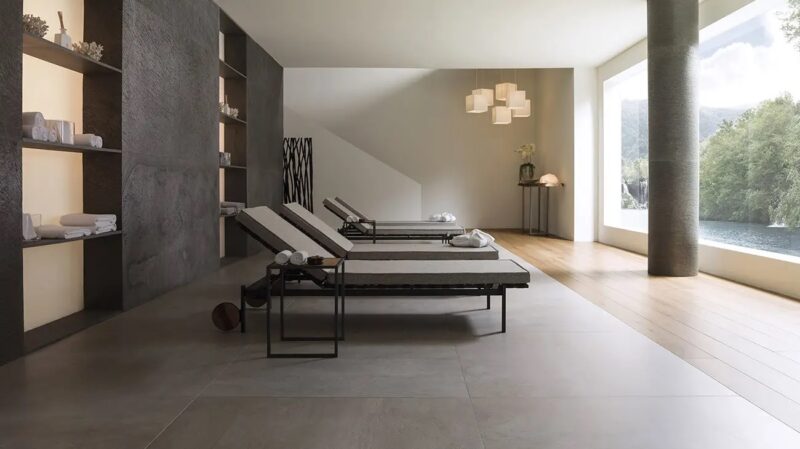Combining two different types of floor is an interesting option to create striking visual effects.
By combining two different floor types, it is possible to play with different colours, textures and materials to create unique and personalized atmospheres, both indoors and out. In this post we will explore the benefits and some design ideas for combining two different types of floor.
Any new project or renovation is defined by the floor, which is a key element in interior design. When combining two different types of floor, it is important to consider the purpose and function of the space so that the aesthetics are aligned with the desired ambience.
The contrast between materials helps to visually delimit different areas in a space, framing, for example, the living room in an open kitchen. By mixing contrasting surfaces, a unique aesthetic can be achieved that captures attention and adds depth to any space.

Wood look tile Vancouver Sand , Cement Look tile Trento Grey
Keys to linking two different types of floor
Each material has its own characteristics and benefits. When combining two different types of floor, it is important to consider their technical properties. Resistance to wear and high traffic or tolerance to chemicals are some of the things to keep in mind. Below we outline some of the fundamental keys to the integration of combined floors.
o Height. When combining different types of floor, it is essential that the floor heights are compatible. Take into account both the thicknesses of the flooring and the thicknesses of the laying materials. However, if it is necessary to conceal an unevenness in the floor, use a transition profile to create an aligned and safe surface.
o Intended use of the space. When deciding on materials to combine two different floors, think about who will be using the space and what activity it will be used for. Planning the design of combined floors for a school, a shopping center or a house are all quite different.
o Texture and colour of materials. To unite two different types of floor, it is important to consider the texture and colours of both in order to achieve an ambience with personality and relief.
o Use of profiles (Butech). To highlight the junction of two different floor types, profiles can be used that are positioned at the same level as the floor. Butech profiles enhance the elegance and modernity of the transitions between different types of floor. Metal profiles go beyond aesthetics, making a smoother transition between the different flooring designs and delivering additional protection to the tile edges.
Combining two different types of floor in a home
Today’s homes are defined by spaces with exquisite and refined taste. A good result invariably requires the meticulous selection of materials, furniture and decorative elements in each room.
The diversity of designs, effects and materials makes it possible for two different floor types to be combined to create a sophisticated and characterful ambience. Find out below how to create unique environments in the rooms where two different floors are most commonly used together:

Aria White Polished and 1l Herringbone
Transition between the kitchen floor and the living room. One of the most common floor combinations is the transition between materials in different rooms. For example, a wooden floor (natural, laminate or vinyl) from L’Antic Colonial in the living room can be combined with a ceramic floor in the kitchen. The combination of the wooden floor with ceramic tiles creates a visual connection between these spaces. At the same time, it takes advantage of the technical and aesthetic qualities of each material.

Marmol look Portofino Pulido and wood look Manhattan Colonial
Combining two types of floor between the bedroom and the bathroom. For this combination, a highly recommended option is the application of a wood-effect ceramic tile in the bedroom area to add warmth to the space. To complement it, we can select a marble or stone effect ceramic in the bathroom area, providing luminosity and a greater feeling of spaciousness.

Bianco Pulido and Tanzania Silver
Create a focal point with the combination of floor types. This is an effective strategy to highlight a particular area, adding visual interest to the environment. This technique can be used in different contexts and rooms. One example is combining parquetry and ceramic tiles to create a carpet effect with the floor tiles in the area to be highlighted.
Combining two different floor types in commercial spaces
Commercial spaces or those open to the public are defined by high daily traffic. Here we’ll show you some designs for the combination of two different floor types in commercial spaces:
• Carpet effect. Combining two different floor types can be an effective technique to create original spaces within the customer experience.
• Pattern or design. Combining two different floor types adds visual interest and creates a distinctive contrast. Patterns can also help to hide the transition between the two floor types and provide a more seamless appearance.

Harlem Acero and Delaware Nogal
When applying combined floors it is necessary to take into account the requirements that must be met by all floors in such buildings. Safety, accessibility and durability of the material should guide your choice.
Some of the factors to be considered are:
o Durability and resistance. The floor tiles must be resistant to traffic and constant use.
o Anti-slip. To prevent slips and falls, especially in areas where moisture may be present, slip-resistant surfaces should be used.
o Accessibility. The floor tiles should be accessible to everybody, including people with physical or visual disabilities.
o Maintenance and cleaning. Floor tiles in public spaces should be easy to maintain and clean. They need to be able to withstand the accumulation of dirt and stains. In this sense, ceramics are one of the easiest materials to maintain.
o Aesthetics. Different materials, colours and patterns can be used to create attractive and welcoming environments in the combination of two different floor types.
o Resistance to climatic and environmental conditions. Floor tiles must be able to withstand the climatic and environmental conditions to which they will be exposed. Combined floors both inside and out must be resistant to moisture, temperature changes and sunlight, among other factors.

Rodano Acero combined with Nobu Roble
Continuity assured in combined floors
The textures and ways in which two different floors are combined together generate dynamism and style. In this way, the surfaces of the various rooms – whether in a home, shop or public space – are given a unique touch.
In addition, the versatile design of some materials allows for different ways of installation. This helps to combine two different floor types more creatively.

Split Pyramid Brown cambined with Heritage Madrid and Heritage Girona
For smooth transitions between different floors, a good strategy is to use patterns that share similar colours or textures. Applying this technique with ceramic tiles imitating hydraulic tiles or with hexagonal shapes, for example, facilitates the integration and attenuation of joints. This allows you to obtain a cleaner result.
In summary, combining two different floor types is a way to add style and personality to any space. The combination of two different floor types can create surprising visual effects. Considering the function of the space, the durability of the materials and the maintenance required will help you select the best designs for unique combinations.






